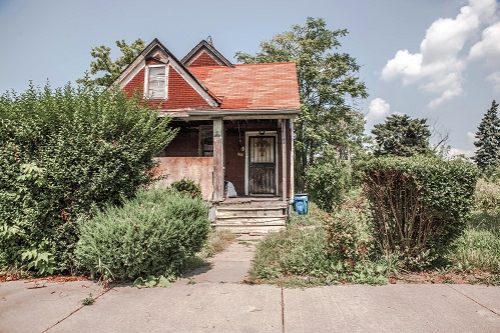- Where is the home insurance crisis affecting people the most?
- How many people have had their home insurance canceled?
- What state are insurance companies pulling out of?
- States with the biggest home insurance rate increases
- The response to the home insurance crisis
- What happens if you can't get homeowners insurance?
- How homeowners can find affordable insurance
- Methodology
- FAQ: Home insurance crisis
Where is the home insurance crisis affecting people the most?
Without a doubt, California and Florida are the hardest hit, although New York and Georgia appeared in the top five on both survey questions related to policy problems.
Our survey found that California and Florida are nearly on par for the number of people who reported having a policy canceled due to the insurance company leaving the state. New York was a close third, followed by Georgia and Texas.
Of these five, four are in the path of hurricanes, and the fifth, California, faces the annual and growing threat of wildfires.
The national average in our survey was 9.3%, which means that just under 10% of the people we surveyed have had a home insurance policy canceled because the home insurance company left the state.
In California, 18% of survey respondents said they had a policy canceled, 17% of those in Florida said they had a cancellation and 16% of New Yorkers said they were hit.
It’s worth noting that about a quarter of survey respondents were in states with a high risk of natural disasters (Florida, Louisiana, New Jersey, New York and Texas.)
However, these numbers make it clear that these cancellations are not rare occurrences.
Florida and California also topped the list when we asked homeowners if their selection of home insurance companies is shrinking. An incredible 57% of Floridians said yes, and 49% of Californians said the same.
How many people have had their home insurance canceled?
Rate increases are the least of some homeowners’ worries. Insurance companies have canceled or non-renewed home insurance policies as they pull out of states where the risk has grown too great.
While a home insurance policy can be canceled for various reasons, we focused on cancellations due to the company leaving the state, indicating the current crisis likely played a role.
Here are the top 10 states where homeowners reported a home insurance company canceled their policy and left the state.
State % reported policy canceled by insurer no longer doing business in state California 18% Florida 17% New York 16% Georgia 16% Indiana 13% Texas 12% Illinois 11% Arizona 11% New Jersey 9% Pennsylvania 8%
What state are insurance companies pulling out of?
As home insurance companies move away from high-risk areas, homeowners shopping for coverage have fewer options. When we asked homeowners if they felt there were fewer home insurance companies in their area, many said yes. Again, California and Florida respondents were most likely to say they have fewer places to buy home insurance. Big names like State Farm and Allstate have left the California market, while the list of companies that have pulled out of Florida includes Farmers and United Insurance Holdings.
Massachusetts was a surprise in the third spot; although the state is in the path of hurricanes, problems with home insurance there haven’t been widely publicized, highlighting a more widespread problem than the news cycle indicates.
Here are the top 10 states where homeowners reported a shrinking number of insurance companies to choose from.
| State | % reported policy canceled by insurer no longer doing business in state |
|---|---|
| California | 18% |
| Florida | 17% |
| New York | 16% |
| Georgia | 16% |
| Indiana | 13% |
| Texas | 12% |
| Illinois | 11% |
| Arizona | 11% |
| New Jersey | 9% |
| Pennsylvania | 8% |
States with the biggest home insurance rate increases
The states with the biggest increases in home insurance premiums since 2022 are Arizona, Texas, Illinois, Arkansas and Louisiana. California and Florida both saw double-digit increases. And the premium increases are likely to continue.
On top of policy cancellations and reduced options, home insurance is getting more expensive. Per S&P Global’s recent analysis, home insurance rates have risen the most in Arizona, followed by Texas and Illinois. Look at the table below to see how much rates have increased into 2023 year-to-date (YTD).
“I think all the coastal states are going to see premiums increase, but the eastern seaboard particularly is exposed,” Wells says.
| State | Increase in 2022 | Increase in 2023YTD | 2022-2023 YTD, cumulative |
|---|---|---|---|
| Alabama | 3.6% | 8.4% | 12.3% |
| Alaska | 1.0% | 4.2% | 5.3% |
| Arizona | 11.2% | 18.4% | 31.6% |
| Arkansas | 4.9% | 15.0% | 20.7% |
| California | 3.2% | 9.0% | 12.5% |
| Colorado | 8.8% | 4.6% | 13.8% |
| Connecticut | 3.4% | 5.9% | 9.5% |
| Delaware | 2.9% | 3.2% | 6.2% |
| District of Columbia | 2.0% | 2.3% | 4.4% |
| Florida | 9.6% | 4.2% | 14.1% |
| Georgia | 4.2% | 5.1% | 9.5% |
| Hawaii | 3.1% | 1.8% | 4.9% |
| Idaho | 4.8% | 6.5% | 11.5% |
| Illinois | 6.4% | 16.3% | 23.7% |
| Indiana | 5.5% | 9.3% | 15.2% |
| lowa | 7.7% | 7.5% | 15.7% |
| Kansas | 4.7% | 7.6% | 12.6% |
| Kentucky | 4.4% | 10.6% | 15.5% |
| Louisiana | 6.5% | 13.7% | 21.0% |
| Maine | 1.2%% | 5.8% | 7.1% |
| Maryland | 6.0% | 5.8% | 12.1% |
| Massachusetts | 4.5% | 8.3% | 13.2% |
| Michigan | 3.4% | 10.0% | 13.7% |
| Minnesota | 6.7% | 11.1% | 18.5% |
| Mississippi | 4.0% | 3.1% | 7.3% |
| Missouri | 6.3% | 6.2% | 12.8% |
| Montana | 6.9% | 9.0% | 16.6% |
| Nebraska | 6.7% | 13.5% | 21.1% |
| Nevada | 1.4% | 3.4% | 4.8% |
| New Hampshire | 4.0% | 4.0% | 8.1% |
| New Jersey | 3.7% | 2.8% | 6.7% |
| New Mexico | 6.6% | 10.9% | 18.2% |
| New York | 3.2% | 6.3% | 9.7% |
| North Carolina | 12.3% | 8.7% | 22.1% |
| North Dakota | 2.4% | 7.6% | 10.2% |
| Ohio | 5.8% | 5.6% | 11.7% |
| Oklahoma | 10.7% | 9.5% | 21.1% |
| Oregon | 10.3% | 10.9% | 22.3% |
| Pennsylvania | 5.0% | 5.8% | 11.1% |
| Rhode Island | 5.1% | 10.9% | 16.5% |
| South Carolina | 2.1% | 4.3% | 6.5% |
| South Dakota | 7.5% | 10.7% | 19.0% |
| Tennessee | 4.6% | 10.5% | 15.6% |
| Texas | 10.6% | 16.4% | 28.7% |
| Utah | 8.5% | 13.6% | 23.2% |
| Vermont | 1.1% | 2.5% | 3.6% |
| Virginia | 4.8% | 7.8% | 13.0% |
| Washington | 3.2% | 8.5% | 11.9% |
| West Virginia | 2.2% | 3.8% | 6.1% |
| Wisconsin | 5.2% | 5.3% | 10.8% |
Source: S&P Global Market Intelligence
The response to the home insurance crisis
The response to increasing rates, policy cancellations and insurance companies pulling back in high-risk states has been varied.
State governments are reviewing everything from rate increase regulations to fees on home insurance policies designed to create a protective fund for companies that can’t cover claims.
We asked our survey respondents if they think it’s fair to pay an additional fee on their home insurance policy to help cover claims for others.
When taking a look at just the bigger states – in which there were 25 or more state residents – we found that 25% of the respondents thought it was fair, but opinions varied widely by state. Virginia had the highest rate of approval for the fees, with 43.3% of respondents saying it was fair. California and New York had similar approval rates, with Wisconsin and Georgia rounding out the top five.
Meanwhile, Wisconsin’s neighbors in Minnesota had the lowest rate of approval for the fees at only 9.1%.
The five states with the highest approval rating for the fees are:
- Virginia 43.3%
- California 42.6%
- New York 41.5%
- Wisconsin 39.3%
- Georgia 39.2%
The three states with the lowest approval rating for the fees are:
- Minnesota 9.1%
- Massachusetts 11.8%
- Maryland 12.5%
Fees aren’t the only approach to helping the home insurance industry. In California, insurance regulators are moving to allow insurance companies to factor climate change into their rating systems.
In Florida, legislation has been introduced to reduce the high levels of insurance litigation in the state and its accompanying costs. Other moves have included expanding access to the state’s My Safe Florida Home program, which provides grants to homeowners to cover upgrades and improvements to protect against hurricane damage.
These moves aim to keep insurance companies in the state and help homeowners make their homes more insurable.
However, homeowners can expect rate increases not only despite but also because of some of these moves. Rate increases are needed to help insurers recover from major losses and stay solvent. For some, home insurance rates have already become unaffordable.
“Regulators have to balance the interests of consumers with the interests of the insurance companies. Regulators have to understand that if it’s not a profitable business, carriers are not going to write it,” Wells says. “With all these rising construction costs and severe weather events, the industry is demanding more premium and if we don’t let them earn a reasonable profit? They will leave. Fewer carriers in the state reduces competition and choice, and that’s not good for consumers.”
What happens if you can't get homeowners insurance?
If you have trouble getting homeowners insurance coverage, you have options. First, contact a local agent who knows more about which companies operate in your area. If you still can't get homeowners insurance, you will need to reach out to your state's insurer of last resort.
Called FAIR plans, most states have a program that ensures homeowners can get the coverage they need. In Florida, Citizens Insurance is the state-backed insurer of last resort. While these plans offer coverage to people in high-risk areas, homeowners insurance premiums often quite expensive.
How homeowners can find affordable insurance
Home insurance rates are likely to rise across the country, but for people in high-risk areas, the increases can be astronomical.
The first thing homeowners should do to head off rate increases and keep their homes insurable is to upgrade whatever they can to wind, hail and fire-resistant materials. Not only do insurance companies offer discounts for these upgrades, but they might also prevent a nonrenewal notice.
If it’s not a nonrenewal you’re facing but a rate increase, it’s time to shop around.
“I recommend getting quotes from the direct writers — State Farm, Farm Bureau, etc. and also contact at least two independent insurance agencies. Independent agents represent multiple carriers and can shop your account to find the best deal for you,” Wells says.
However, rate increases are likely inevitable. You can look to other options to reduce your rates, like discounts.
“Also, be prepared to take on a higher deductible. I have a 1% deductible on windstorm, which is all I really want to have, but if I’ll go to 2% I can save quite a bit on my HO policy,” Wells says.
Compare home insurance rates across states for 2024.
Methodology
In the summer of 2023, Insurance.com polled 1,500 homeowners nationwide about home insurance. They were asked if they had received a home insurance policy cancelation in the past 12 months due to a company leaving the state and whether they felt their options for home insurance had been reduced. We also asked respondents if they believe the fees in some states to cover private insurance companies when they cannot pay their claims are fair. Slice MR conducted the survey on behalf of Insurance.com.
FAQ: Home insurance crisis
Is it hard to get homeowners insurance in Florida?
In some parts of the state, yes. The more vulnerable an area is to hurricanes, the harder it is to find homeowners insurance.
Why are home insurance companies leaving California?
The high risk and costs associated with worsening wildfires has led some California homeowners insurance companies to stop offering new coverage.
How many insurance companies have left California?
At least eight home insurance companies have stepped back from the California homeowners insurance market. However, these insurance companies haven't really left California, they have simply stopped writing new policies. The companies that have so far announced either a halt to new policies or reduced coverage in California are:
- State Farm
- Allstate
- Corebridge Direct
- Chubb
- Falls Lake Insurance
- AmGUARD
- Tokio Marine America Insurance Co.
- Trans Pacific Insurance Co.




